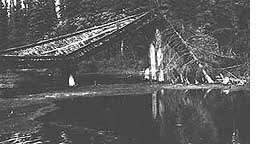
Pilings That Grow
Most often, we associate construction problems in the north with that sinking feeling as the underlying permafrost melts. Under certain circumstances, though, the problem may be just the reverse, and piles or buried footings may be squirted out of the ground almost like toothpaste from a tube.
The culprit is frost heaving. The type of frost heaving responsible for this bizarre behavior occurs in very fine-grained soil in areas where water can be supplied from below the frost line during the winter. As the ground in the upper layers freezes, it expands--particularly if it is a clay soil. Some clays can nearly double in volume when they freeze.
In areas where the water supply is abundant, freezing soil can create forces which literally push telephone poles or bridge pilings out of the ground. As water is added from below, the freezing and expansion continues through the winter, placing enormous pressures on any foreign object (such as a piling) that might be present. Because the only direction from which a piling does not receive these pressures is straight up, that is the direction in which it is forced to move.
Neil Davis has reported in an earlier column that the upward pressure on the end of a piling under these circumstances can be as great as 60 pounds per square inch. For a piling 20 inches in diameter, that amounts to an upward force on its bottom of about 20,000 pounds. But if there is a bonding between the sides of the piling and the surrounding soil, this also provides lift. If the pile is buried to a depth of 4 feet, the total upward force would be about ten times as much as that supplied by the base alone, or about 200,000 pounds--the weight of a fair-sized locomotive.
If the conditions are favorable for this sort of thing, a piling can be forced upward by about a foot each year, and it doesn't require too long for the earth to spit it out altogether. In the early l950s this happened to the wooden pilings supporting a bridge across the outlet of Clearwater Lake, eight miles southeast of Big Delta. The soil under the center of the stream did not freeze during the winter, but it did near the shore. Eventually, the seasonal freezing and thawing at the ends of the bridge lifted the pilings supporting the end spans full length into the air.





